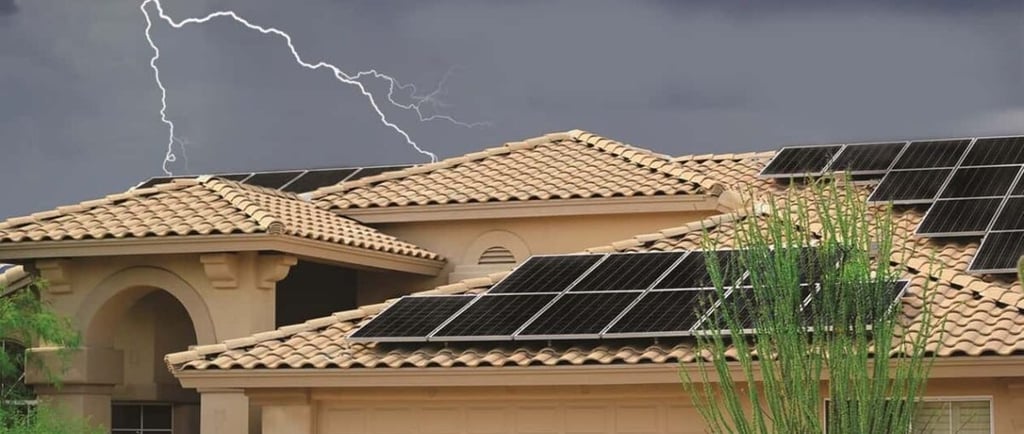The Resilience of Solar Panels During Hurricanes: A Statistical Insight
Many business and homeowners have misconstrued opinions of solar effectiveness before, during, and after a major storm. This blog explains the factual evidence:
Pangea SUN Solutions
6/22/20242 min read


As climate change continues to influence weather patterns, the frequency and intensity of hurricanes have become a pressing concern. Amidst this, the resilience of solar panels during such extreme weather events has garnered significant attention. This blog post delves into the statistics behind solar panel performance during hurricanes, shedding light on their durability and the implications for sustainable energy infrastructure.
Solar Panels and Hurricanes: An Overview
Solar panels, primarily made from photovoltaic cells, are designed to harness sunlight and convert it into electricity. Their installation has surged globally, driven by the push for renewable energy. However, their exposure to the elements, especially during hurricanes, raises questions about their reliability and longevity.
Structural Resilience: Engineering for Extreme Weather
Modern solar panels are engineered to withstand harsh weather conditions, including high winds and heavy rains typical of hurricanes. Key statistics from studies and real-world data illustrate their resilience:
Wind Resistance: Solar panels are generally rated to endure wind speeds of up to 140 mph (225 kph), which covers most Category 1 to Category 3 hurricanes. For example, the Florida Building Code requires solar installations to withstand winds up to 150 mph (240 kph).
Survival Rates: Data from hurricanes such as Irma (2017) and Maria (2017) provide valuable insights. During Hurricane Irma, which had sustained winds of 130 mph (209 kph), most solar installations in Florida sustained minimal damage. A report by the Rocky Mountain Institute found that only 5-10% of panels experienced damage, primarily from flying debris rather than structural failure.
Hurricane Maria Case Study: In Puerto Rico, Hurricane Maria devastated the island in 2017 with winds reaching 155 mph (250 kph). Despite the severe impact, many solar installations demonstrated remarkable resilience. The National Renewable Energy Laboratory (NREL) reported that solar systems installed with modern standards had a 92% survival rate. Damages were often linked to improper installation rather than panel design.
Post-Hurricane Performance: Rapid Recovery
Beyond structural integrity, the performance of solar panels post-hurricane is crucial for disaster recovery and energy resilience:
Quick Restoration: In many cases, solar panels that remain intact can resume electricity generation almost immediately after a hurricane, unlike traditional power infrastructure, which may suffer prolonged outages. For instance, in the aftermath of Hurricane Sandy (2012), solar-powered microgrids were pivotal in providing electricity to critical facilities.
Energy Independence: Solar installations with battery storage systems offer a significant advantage. These systems can store excess energy generated during sunny periods, ensuring a continuous power supply even when the grid is down. During Hurricane Maria, solar-plus-storage systems in Puerto Rico provided essential power for medical facilities and emergency services.
Enhancing Solar Resilience: Future Directions
The promising performance of solar panels during hurricanes underscores the potential for further enhancing their resilience. Key strategies include:
Improved Installation Practices: Ensuring that solar panels are installed following stringent guidelines is critical. Proper mounting and securing methods can significantly reduce damage from high winds and flying debris.
Advanced Materials: Research into more robust materials and designs continues. Innovations such as flexible solar panels and impact-resistant coatings are being explored to enhance durability.
Integrated Energy Systems: Combining solar panels with other renewable energy sources and storage systems can create more resilient and self-sufficient energy networks. Microgrids, in particular, offer a decentralized approach to energy distribution, reducing dependency on vulnerable central grids.
Conclusion
Solar panels have demonstrated impressive resilience during hurricanes, supported by robust engineering and strategic installation practices. The statistics reveal that with proper implementation, solar energy systems can not only withstand extreme weather but also play a crucial role in post-disaster recovery. As we face an era of increasing climate uncertainty, investing in resilient solar infrastructure is a forward-thinking approach to ensuring sustainable and reliable energy for the future.
